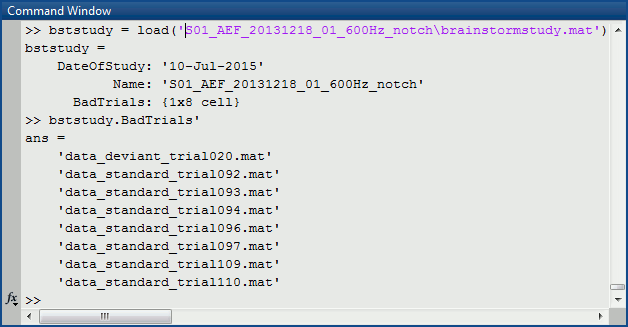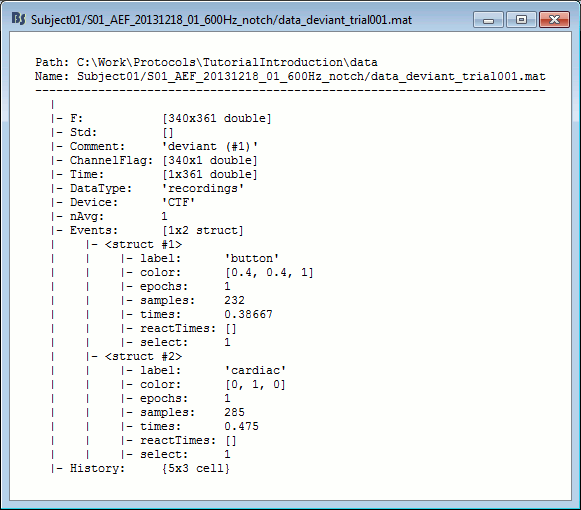|
Size: 14622
Comment:
|
Size: 9145
Comment:
|
| Deletions are marked like this. | Additions are marked like this. |
| Line 1: | Line 1: |
| = Tutorial 10: Epoching = | = Tutorial 15: Import epochs = |
| Line 3: | Line 3: |
We can consider that our datasets are clean from any major artifact. We will now proceed to the analysis of the brain signals we recorded in response to the auditory stimulation. There are two major types of processing workflows for MEG/EEG, depending on whether we are dealing with an event-related paradigm or a steady-state/resting-state study. This tutorial will only focus on the event-related case: series of stimuli are sent to the subject and we have the corresponding triggers marked in the recordings. We will base our analysis on those triggers, import short epochs around each of them and average them. You will find in the advanced tutorials a scenario of MEG resting-state analysis. |
|
| Line 6: | Line 10: |
| = From auditory = == Epoching and averaging == |
== Import in database == Until now, we've only been looking at data that was read from continuous files. The raw file viewer provides a rapid access to the recordings, but many operations can only be applied to short segments of recordings that have been imported in the database, that we will refer to as "epochs" or "trials". |
| Line 9: | Line 13: |
| === Import recordings === To import epochs from '''Run01''': |
* Right-click on '''Run#01''' > '''Import in database'''. <<BR>><<BR>> {{attachment:import_popup.gif||height="152",width="298"}} * Set the import options as they as described below: <<BR>><<BR>> {{attachment:import_options.gif||height="366",width="587"}} |
| Line 12: | Line 16: |
| * Right-click on the "Link to raw file" > '''Import in database''' | * '''Time window''': Time range of interest. We are interested by all the stimulations, so do not change this parameter; the default values always represent the entire file. * '''Split''': Useful to import continuous recordings without events, to import successive chunks of the same duration. We do not need this here. * '''Events selection''': Check the "Use events" option, and select both "'''standard'''" and "'''deviant'''". <<BR>>The number between parenthesis represents the number of occurrences of each event in the selected time window (changes if you modify the time definition at the top of the window) * '''Epoch time''': Time segment that is extracted around each event marker. Set it to '''[-100,+500]ms'''. * '''Apply SSP/ICA projectors''': Use the active SSP projectors calculated during the previous pre-processing steps. Always check the summary of the projectors that are selected. <<BR>>Here there are 2 categories ("cardiac" and "blink") with a total of 3 projectors selected (one in "cardiac" and two in "blink", the blink and the saccade). Keep this option selected. * '''Remove DC Offset''': Check this option, select '''Time range: [-100, 0] ms'''. For each epoch, it will: * Compute the average of each channel over the baseline (pre-stimulus interval: [-100,0]ms) * Subtract it from the channel at every time instants (full epoch interval: [-100,+500]ms). * This option removes the baseline value of each sensor. In MEG, the sensors record variations around a somewhat arbitrary level, therefore this operation is always needed, unless it was already applied during one of the pre-processing steps. * Note that a high-pass filter with a very low frequency (for instance 0.3Hz) can replace efficiently this DC correction. If a high-pass filter has already been applied to the recordings, you may want to unselect this option. * '''Resample recordings''': Keep this unchecked * '''Create a separate folder for each epoch type''': Do __not__ check this option. * If selected: a new folder is created for each event type ("standard" and "deviant") * If not selected: all the epochs are saved in a new folder, the same one for all the events, that has the same name as the initial raw file. This is what we want. * In this case, we have to select this second option because we have two acquisition runs with different channel files (different head positions and different SSP projectors) to import for the same subject. If we select this option, the "standard" epochs of both runs would be imported in the same folder and would end up sharing the same channel file, which is not correct because the channel files for both runs are different. |
| Line 14: | Line 32: |
| * Use events: "'''standard'''" and "'''deviant'''" * Epoch time: '''[-100, +500] ms''' * Apply the existing SSP (make sure that you have 2 selected projectors) * '''Remove DC''' '''offset '''based on time window: '''[-100, 0] ms''' * '''UNCHECK''' the option "Create a separate folder for each epoch type", this way all the epochs are going to be saved in the same Run01 folder, and we will able to separate the trials from Run01 and Run02. |
One new folder appear in Subject01. |
| Line 20: | Line 34: |
| {{http://neuroimage.usc.edu/brainstorm/Tutorials/Auditory?action=AttachFile&do=get&target=import1.gif|import1.gif|height="344",width="521",class="attachment"}} * Note that the trials that are overlapping with a BAD segment are tagged as bad in the database explorer (marked with a red dot). {{http://neuroimage.usc.edu/brainstorm/Tutorials/Auditory?action=AttachFile&do=get&target=import2.gif|import2.gif|class="attachment"}} Repeat the same operation for '''Run02''': * Right-click on the "Link to raw file" > '''Import in database''' * Use the same options as for the previous run. {{http://neuroimage.usc.edu/brainstorm/Tutorials/Auditory?action=AttachFile&do=get&target=import3.gif|import3.gif|height="235",width="216",class="attachment"}} = From continuous tutorials = This tutorial fills the gap between the previous tutorial (review and clean continuous recordings), and the introduction tutorials (source analysis of evoked responses). It explains how to epoch the recordings, do some more pre-processing on the single trials, and then calculate their average. For this tutorial, we are going to use the protocol '''TutorialRaw''' created in the two previous tutorials: [[Tutorials/TutRawViewer|Review continuous recordings and edit markers]] and [[Tutorials/TutRawSsp|Artifact cleaning]]. If you have not followed these tutorials yet, please do it now. == Import in database == The raw file viewer provides a rapid access to the recordings, but most of operations cannot be performed directly on the continuous files: most of the pre-processing functions, averaging, time-frequency analysis and statistical tests can only be applied on blocks of data that are saved in the database (ie. "imported"). After reviewing the recordings and editing the event markers, you have to "import" the recordings in the database to go with further analysis. Right-click on the file with power line correction:''' Raw | notch(60Hz 120Hz 180Hz) > Import in dabase''' {{http://neuroimage.usc.edu/brainstorm/Tutorials/TutRawAvg?action=AttachFile&do=get&target=importMenu.gif|importMenu.gif|class="attachment"}} Warning: If you right-click on the subject node > Import EEG/MEG, and select the tutorial .ds dataset, you would be able to import blocks of the continuous file in the database, but you would not have access to the modified events list or the SSP operators. Therefore, you would not import data cleaned of ocular and cardiac artifacts. The modified events list and the signal space projectors are saved only in the "Link to raw file" in the Brainstorm database, not in the initial continuous file. {{http://neuroimage.usc.edu/brainstorm/Tutorials/TutRawAvg?action=AttachFile&do=get&target=importOptions.gif|importOptions.gif|class="attachment"}} Set the import options as they are represented in this figure: * '''Time window''': Time range of interest. We are interested by all the stimulations, so do not change this parameter; the default values always represent the entire file. * '''Split''': Useful to import continuous recordings without events, to import successive chunks of the same duration. We do not need this here. * '''Events selection''': Check the "Use events" option, and select both "left" and "right". The number in the parenthesis represents the number of occurrences of this event in the selected time window (would change if you modify the time definition on top of the figure) * '''Epoch time''': Time segment that is extracted around each marker and saved in the database. Set it to [-100, +300] ms * '''Use Signal Space Projections''': Use the active SSP projectors calculated during the previous pre-processing steps. Keep this option selected. * '''Remove DC Offset''': Check this option, and select: Time range: [-100, 0] ms. For each epoch, this will: compute the average of each channel over the baseline (pre-stimulus interval: -100ms to 0ms), and subtract it from the channel at every time instants (full epoch interval: [-100,+300]ms). This option removes the baseline value of each sensor, ie. the continuous (DC) offset that is added permanently on top of the recordings of interest. In MEG, the sensors record variations around a somewhat arbitrary level, therefore this operation is always needed, unless it was already applied during one of the pre-processing steps. Note that a high-pass filter with a very low frequency (for instance 0.3Hz) can replace efficiently this DC correction. If a high-pass filter has already been applied to the recordings, you may want to unselect this option. * '''Resample recordings''': Keep this unchecked * '''Create a separate folder for each epoch type''': If selected, a new folder is created for each event type (here, it will create two folders in the database: "left" and "right"). If not selected, all the epochs are saved in a new folder, the same one for all the events, that has the same name as the initial raw file. Click on Import and wait. At the end, you are asked whether you want to ignore one epoch that is shorter than the others. This happens because the acquisition of the MEG signals was stopped less than 300ms after the last stimulus trigger was sent. Therefore, the last epoch cannot have the full [-100,300]ms time definition. This shorter epoch would prevent us from averaging all the trials easily. As we already have enough repetitions in this experiment, we can just ignore it. Answer '''Yes''' to this question to discard the last epoch. {{http://neuroimage.usc.edu/brainstorm/Tutorials/TutRawAvg?action=AttachFile&do=get&target=importShortEpoch.gif|importShortEpoch.gif|class="attachment"}} Two new conditions containing two groups of trials appeared in the database. To expand a group of trials and get access to the individual epochs: double-click on it or click on the "+" next to it. The SSP projectors calculated in the previous tutorial were applied on the fly when reading from the continuous file. Those epochs are clean from eye blinks and power line contamination. All the files available in the ''(Common files)'' folder are also shared for those new folders "left" and "right". |
* It contains a channel file (copied from the continuous file) and two trial groups. To expand a group of trials and access the individual epochs: double-click on it or click on the "+" next to it. <<BR>><<BR>> {{attachment:import_new_folder.gif||height="171",width="226"}} * The SSP projectors calculated in the previous tutorial were applied on the fly when reading from the continuous file. Those epochs are clean from eye blinks and power line contamination. * Note that the trials that are overlapping with a BAD segment are tagged as bad in the database explorer (marked with a red dot). All the bad trials are going to be ignored in the rest of the analysis, because they are ignored by the Process1 and Process2 tabs (see next tutorial). <<BR>><<BR>> {{attachment:import_bad.gif||height="100",width="232"}} |
| Line 68: | Line 39: |
| Double-click on the first trial for the "left" condition. Then right-click on the figure > '''Next data file''', or use the keyboard shortcut '''F3 '''to jump to the next trial. This way you can quickly review all the trials, to make sure that there is no obvious problem in the recordings. If you haven't reviewed manually all the recordings in the continuous mode, and marked all the bad segments, it is a good time to do it now. | After reviewing the continuous file with the "columns" view (channels one below the other) it can be useful to also review the imported trials with the "butterfly" view (all the channels superimposed). * Double-click on the first trial for the "deviant" condition. * Switch to the "butterfly" display mode: in the Record tab, click on the first button in the toolbar. <<BR>><<BR>> {{attachment:import_review.gif||height="172",width="440"}} * Right-click on the figure > Navigator > '''Next data file''', or use the keyboard shortcut '''F3'''. <<BR>>This way you can quickly review all the trials to make sure that there is no obvious problem.<<BR>>Mac users: The keys "Fx" are obtained by holding the "Fn" key simultaneously. <<BR>><<BR>> {{attachment:import_navigator.gif}} |
| Line 74: | Line 49: |
| * Use the keyboard shortcut '''Control+B''' * To set all the trials back as good in a group: right-click on the trials group or the condition > Accept bad trials. |
* Use the keyboard shortcut '''Ctrl+B''' * To set all the trials back as good in a group: right-click on the trials group > Accept bad trials. |
| Line 77: | Line 52: |
| {{http://neuroimage.usc.edu/brainstorm/Tutorials/TutRawAvg?action=AttachFile&do=get&target=rejectManual.gif|rejectManual.gif|class="attachment"}} | == Run #02 == Repeat the same operations for the second dataset: |
| Line 79: | Line 55: |
| When a trial is tagged as bad, its icon in the database explorer shows a red mark. | * Right-click on '''Run#02''' > '''Import in database'''. * Import events "standard" and "deviant" with the same options. <<BR>><<BR>> {{attachment:import_run02.gif||height="150",width="236"}} |
| Line 81: | Line 58: |
| {{http://neuroimage.usc.edu/brainstorm/Tutorials/TutRawAvg?action=AttachFile&do=get&target=rejectTree.gif|rejectTree.gif|class="attachment"}} | <<TAG(Advanced)>> |
| Line 83: | Line 60: |
| All the bad trials are going to be ignored in the rest of the analysis, because they are ignored by the Process1 and Process2 tabs. If you drag and drop the 101 left trials in the Process1 list, with one trial marked as bad, the summary of the selected files on top of the tab would show only 100 data files. | == On the hard drive == Right-click on any imported epoch > File > View file contents: |
| Line 85: | Line 63: |
| {{http://neuroimage.usc.edu/brainstorm/Tutorials/TutRawAvg?action=AttachFile&do=get&target=rejectProcess.gif|rejectProcess.gif|class="attachment"}} | . {{attachment:import_struct.gif||height="418",width="477"}} |
| Line 87: | Line 65: |
| To learn how to mark only individual channels as bad instead of the entire trial, please go back to the introduction tutorial [[http://neuroimage.usc.edu/brainstorm/Tutorials/TutExploreRecodings|Exploring the recordings]]. | ==== Structure of the imported epochs ==== * '''F''': recordings time series (nChannels x nTime), in Volts. |
| Line 89: | Line 68: |
| The process "'''Artifacts > Detect bad channels: peak-to-peak'''" can help you detect automatically some bad trials based on a peak-to-peak amplitude threshold. Drag and drop all the trials from the '''left''' condition in the Process1 list, and select this process. For each trial, it detects the channels that have a peak-to-peak amplitude (maximum value - minimum value) that is above a rejection threshold (too noisy) or below a rejection threshold (no signal). You can define different thresholds for different channel types. The options are: | * '''Std''': Standard deviation or standard error, when available (see next tutorial). * '''Comment''': String displayed in the database explorer to represent this file. * '''ChannelFlag''': One value per channel, 1 means good, -1 means bad. * '''Time''': Time values for each sample recorded in F, in seconds. * '''DataType''': Type of the data saved in the F matrix. * '''Device''': Name of the acquisition system used to record this file. * '''nAvg''': For averaged files, number of trials that were used to compute this file. * '''Events''': Time markers available in the file (stimulus triggers or other events) * '''label''': Name of the event group. * '''color''': [r,g,b] Color used to represent the event group, in Matlab format. * '''epochs''': [1 x Nevt] Indicate in which epoch the event is located (index in the sFile.epochs array), or 1 everywhere for files that are not saved in "epoched" mode. Nevt = number or occurrences of the event = number of markers in this group. * '''samples''': [1 x Nevt] Sample indices of each marker in this group (samples = times * sfreq). For extended events: [2 x Nevt], first row = start, second row = end. * '''times''': [1 x Nevt] Time in seconds of each marker in this group (times = samples / sfreq). For extended events: [2 x Nevt], first row = start, second row = end. * '''reactTimes''': Not used anymore * '''select''': Not used anymore * '''History''': Operations performed on file since it was imported (menu "View file history"). |
| Line 91: | Line 88: |
| * '''Time window''': Time range on which the peak-to-peak amplitude is calculated on each trial * '''Thresholds''': Rejection and detection thresholds for each sensor type. For CTF recordings, use the "MEG gradio" category, and ignore the "/cm (x 0.04)" indication, that is valid only for Neuromag systems. Set the '''MEG gradio''' thresholds to '''[0, 2000] fT''', to detect the MEG channels that have a peak-to-peak amplitude superior to 2000fT. * '''Reject only the bad channels''': This would tag as bad only the detected channels, but would not tag the trial itself as bad. * '''Reject the entire trial''': This would tag as bad the trial if there is at least one channel file identified as bad. |
==== File history ==== Right-click on any imported epoch > File > View file history: |
| Line 96: | Line 91: |
| {{http://neuroimage.usc.edu/brainstorm/Tutorials/TutRawAvg?action=AttachFile&do=get&target=rejectOptions.gif|rejectOptions.gif|class="attachment"}} | . {{attachment:import_history.gif||height="197",width="603"}} |
| Line 98: | Line 93: |
| For this current dataset, the quality of the recordings is remarkably good, we don't need to mark any trial as bad. So right-click on the group of "left" trials > Accept trials, to set them all as good. = From CTF = == MEG recordings == To understand what is stored in the two other files: double-click on the first, then double-click on the second. {{http://neuroimage.usc.edu/brainstorm/Tutorials/TutImportRecordings?action=AttachFile&do=get&target=recordingsErp.gif|recordingsErp.gif|class="attachment"}} {{http://neuroimage.usc.edu/brainstorm/Tutorials/TutImportRecordings?action=AttachFile&do=get&target=recordingsStd.gif|recordingsStd.gif|class="attachment"}} * The first one is the response to the electric stimulation averaged over 400 trials, from 50ms before to 250ms after the stimulus. The values for each MEG sensor is represented by a black line, all the sensors are all overlaid on the same graph. * Roughly, you can observe a first response peak at 23ms, and a second one at about 47ms. * The second one is the standard deviation of the trials that were average, for each sensors and at each time. * You can rename them ''ERF ''(for Evoked Response Field) and ''Std'', to get something more meaningful than ''somMDYO-18av (#1)'' and ''somMDYO-18av (#2)''. Use F2 or any other renaming method. * Close the windows using the ''Close all'' button on the right of the main Brainstorm toolbar. It closes all the figures at the same time and frees all the memory. Always use this instead of closing the figures individually. . {{http://neuroimage.usc.edu/brainstorm/Tutorials/TutImportRecordings?action=AttachFile&do=get&target=closeAllButton.gif|closeAllButton.gif|class="attachment"}} Now have a look at what is inside a recording file: right-click on ''Right/ERP > File > View file contents''. . {{http://neuroimage.usc.edu/brainstorm/Tutorials/TutImportRecordings?action=AttachFile&do=get&target=dataFileMat.gif|dataFileMat.gif|class="attachment"}} * '''F''': recordings time series (nChannels x nTime), in Volts * '''Comment''': String displayed in the Brainstorm database explorer to represent this file * '''ChannelFlag''': one value per channel, 1 means good, -1 means bad (not displayed or processed) * '''Time''': Time values, in seconds * '''DataType''': Type of the data saved in the F matrix (recordings, Z-score...) * '''Device''': Name of the acquisition system used to record this file * '''nAvg''': For averaged files, number of trials that were used to compute this file * '''Events''': Time markers available in the file (stimulus triggers or other events) * '''History''': Operations performed on file since it was imported == Database navigator == The Navigator menu can help you to go quickly from a dataset to another. It can be almost indispensable when your are reviewing 200 trials of the same MEG response. {{http://neuroimage.usc.edu/brainstorm/Tutorials/TutExploreRecodings?action=AttachFile&do=get&target=navigator.gif|navigator.gif|class="attachment"}} * You can access it from the popup menus of all the figures showing functional data. * You can also use the keyboard shortcuts:'' F1, F2, F3'', together with ''Shift ''key to go backwards. * Now, close all the figures (use the ''Close all figures ''button) * For ''Right / ERF'', display three views : * Time series (double click) * 2D sensor cap (Ctrl+T)''' ''' * 2D Layout (right click on ERF file > Display > 2D Layout) * Press ''F3 ''once: Updates all the figures to display ''Right/Std'' and selects it in the database explorer * Press ''F3 ''again: Nothing happens, you are already at the last dataset for this subject / condition. * Press ''Shift + F3'': And you'll be back to ''ERF ''file. * Press ''F2'': Similar to F3, but jumps from a condition to another, within the same subject. * If you had many subjects you could also use ''F1 / Shift+F1''. * MacBook users: The keys "Fx" are obtained by holding the "Fn" key simultaneously. |
==== List of bad trials ==== * There is no field in the file structure that says if the trial is good or bad. * This information is saved at the level of the folder, in the '''brainstormstudy.mat''' file. * Right-click on an imported folder > File > Show in file explorer.<<BR>><<BR>> {{attachment:import_folder.gif||height="314",width="497"}} * Load the brainstormstudy.mat file into Matlab: <<BR>><<BR>> {{attachment:import_study.gif||height="259",width="499"}} |
Tutorial 15: Import epochs
Authors: Francois Tadel, Elizabeth Bock, Sylvain Baillet
We can consider that our datasets are clean from any major artifact. We will now proceed to the analysis of the brain signals we recorded in response to the auditory stimulation. There are two major types of processing workflows for MEG/EEG, depending on whether we are dealing with an event-related paradigm or a steady-state/resting-state study.
This tutorial will only focus on the event-related case: series of stimuli are sent to the subject and we have the corresponding triggers marked in the recordings. We will base our analysis on those triggers, import short epochs around each of them and average them. You will find in the advanced tutorials a scenario of MEG resting-state analysis.
Import in database
Until now, we've only been looking at data that was read from continuous files. The raw file viewer provides a rapid access to the recordings, but many operations can only be applied to short segments of recordings that have been imported in the database, that we will refer to as "epochs" or "trials".
Right-click on Run#01 > Import in database.
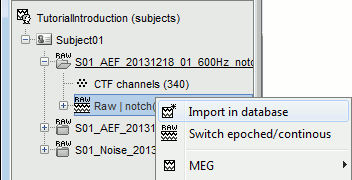
Set the import options as they as described below:
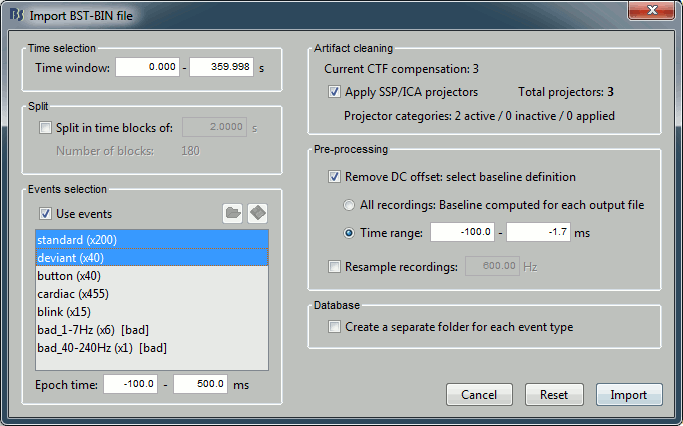
Time window: Time range of interest. We are interested by all the stimulations, so do not change this parameter; the default values always represent the entire file.
Split: Useful to import continuous recordings without events, to import successive chunks of the same duration. We do not need this here.
Events selection: Check the "Use events" option, and select both "standard" and "deviant".
The number between parenthesis represents the number of occurrences of each event in the selected time window (changes if you modify the time definition at the top of the window)Epoch time: Time segment that is extracted around each event marker. Set it to [-100,+500]ms.
Apply SSP/ICA projectors: Use the active SSP projectors calculated during the previous pre-processing steps. Always check the summary of the projectors that are selected.
Here there are 2 categories ("cardiac" and "blink") with a total of 3 projectors selected (one in "cardiac" and two in "blink", the blink and the saccade). Keep this option selected.Remove DC Offset: Check this option, select Time range: [-100, 0] ms. For each epoch, it will:
- Compute the average of each channel over the baseline (pre-stimulus interval: [-100,0]ms)
- Subtract it from the channel at every time instants (full epoch interval: [-100,+500]ms).
- This option removes the baseline value of each sensor. In MEG, the sensors record variations around a somewhat arbitrary level, therefore this operation is always needed, unless it was already applied during one of the pre-processing steps.
- Note that a high-pass filter with a very low frequency (for instance 0.3Hz) can replace efficiently this DC correction. If a high-pass filter has already been applied to the recordings, you may want to unselect this option.
Resample recordings: Keep this unchecked
Create a separate folder for each epoch type: Do not check this option.
- If selected: a new folder is created for each event type ("standard" and "deviant")
- If not selected: all the epochs are saved in a new folder, the same one for all the events, that has the same name as the initial raw file. This is what we want.
- In this case, we have to select this second option because we have two acquisition runs with different channel files (different head positions and different SSP projectors) to import for the same subject. If we select this option, the "standard" epochs of both runs would be imported in the same folder and would end up sharing the same channel file, which is not correct because the channel files for both runs are different.
One new folder appear in Subject01.
It contains a channel file (copied from the continuous file) and two trial groups. To expand a group of trials and access the individual epochs: double-click on it or click on the "+" next to it.
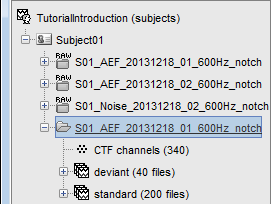
- The SSP projectors calculated in the previous tutorial were applied on the fly when reading from the continuous file. Those epochs are clean from eye blinks and power line contamination.
Note that the trials that are overlapping with a BAD segment are tagged as bad in the database explorer (marked with a red dot). All the bad trials are going to be ignored in the rest of the analysis, because they are ignored by the Process1 and Process2 tabs (see next tutorial).
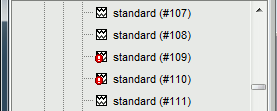
Review the individual trials
After reviewing the continuous file with the "columns" view (channels one below the other) it can be useful to also review the imported trials with the "butterfly" view (all the channels superimposed).
- Double-click on the first trial for the "deviant" condition.
Switch to the "butterfly" display mode: in the Record tab, click on the first button in the toolbar.
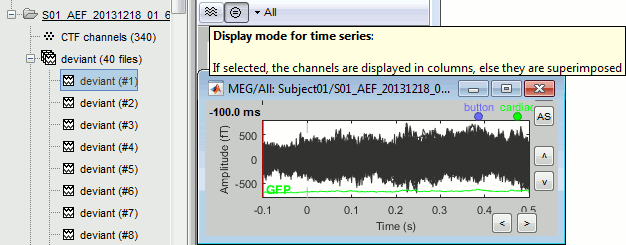
Right-click on the figure > Navigator > Next data file, or use the keyboard shortcut F3.
This way you can quickly review all the trials to make sure that there is no obvious problem.
Mac users: The keys "Fx" are obtained by holding the "Fn" key simultaneously.

To mark a trial as bad manually, you have three methods:
Right-click on the trial file in the database > Reject trial
Right-click on the figure > Reject trial
Use the keyboard shortcut Ctrl+B
To set all the trials back as good in a group: right-click on the trials group > Accept bad trials.
Run #02
Repeat the same operations for the second dataset:
Right-click on Run#02 > Import in database.
Import events "standard" and "deviant" with the same options.

On the hard drive
Right-click on any imported epoch > File > View file contents:
Structure of the imported epochs
F: recordings time series (nChannels x nTime), in Volts.
Std: Standard deviation or standard error, when available (see next tutorial).
Comment: String displayed in the database explorer to represent this file.
ChannelFlag: One value per channel, 1 means good, -1 means bad.
Time: Time values for each sample recorded in F, in seconds.
DataType: Type of the data saved in the F matrix.
Device: Name of the acquisition system used to record this file.
nAvg: For averaged files, number of trials that were used to compute this file.
Events: Time markers available in the file (stimulus triggers or other events)
label: Name of the event group.
color: [r,g,b] Color used to represent the event group, in Matlab format.
epochs: [1 x Nevt] Indicate in which epoch the event is located (index in the sFile.epochs array), or 1 everywhere for files that are not saved in "epoched" mode.
samples: [1 x Nevt] Sample indices of each marker in this group (samples = times * sfreq).
times: [1 x Nevt] Time in seconds of each marker in this group (times = samples / sfreq).
reactTimes: Not used anymore
select: Not used anymore
History: Operations performed on file since it was imported (menu "View file history").
File history
Right-click on any imported epoch > File > View file history:
List of bad trials
- There is no field in the file structure that says if the trial is good or bad.
This information is saved at the level of the folder, in the brainstormstudy.mat file.
Right-click on an imported folder > File > Show in file explorer.
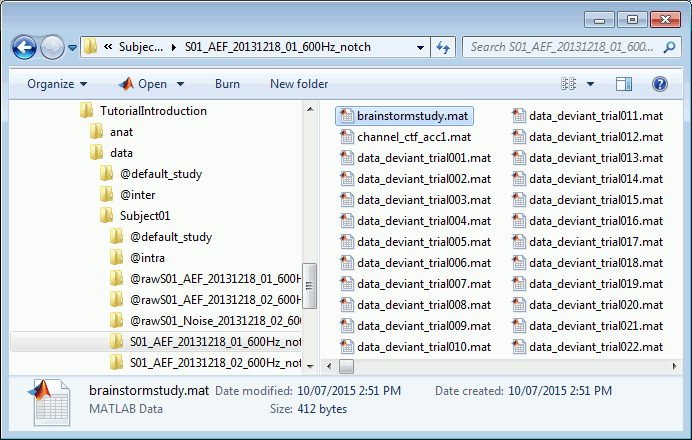
Load the brainstormstudy.mat file into Matlab:
